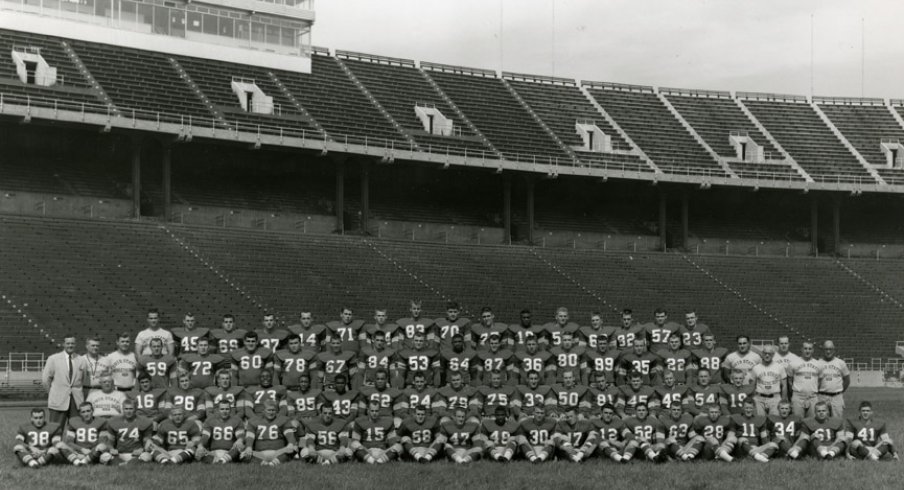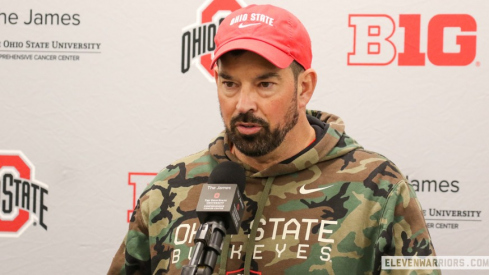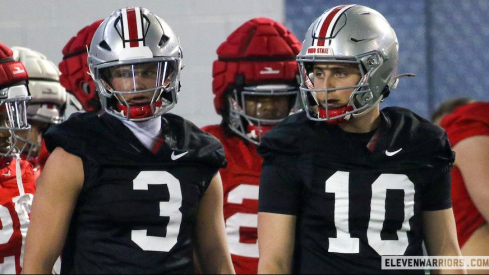Fresh off two straight Big Ten titles and a Rose Bowl victory, Woody Hayes had Ohio State humming as the hottest team in the conference. He also opened his mouth about the difficulty players had paying for school.
Probation
The attention Hayes brought to the financial struggles of student-athletes backfired. He spoke freely about loaning his players money on his weekly television show and the benefits of jobs program for athletes. The NCAA investigated the loans and work program during the 1955 season and found the players received payment without working.
In April 1956, the NCAA placed Ohio State on probation for one year. That banned the Buckeyes — all sports, not just the football team — from playing in the Rose Bowl or in an NCAA-sanctioned tournament. Hayes felt the penalties were too steep, but he and the Buckeyes did not appeal.
| The 1956 Buckeyes | |
|---|---|
| Record | 6–3 |
| B1G Record | 4–2, 4th |
| Coach | Woody Hayes (6th year, 39–14–2) |
| CaptainS | Frank Ellwood and Bill Michael |
Games of Note
September 29th • Nebraska • Ohio Stadium
Nebraska's Bill Glassford resigned following the 1955 season. Ohio State knew the man who replaced him well, however.
The Cornhuskers hired Pete Elliott, a former Michigan player. He entered Ohio Stadium with a 1–0 career coaching record, fresh off a 34-6 win against South Dakota a week earlier. An away game against No. 8 Ohio State proved to be a more difficult task.
The Buckeyes' first points of the season came off a blocked punt. Leo Brown broke through the Cornhuskers' line, deflected the kick, then scooped it up at the 18 and scampered in for the score.
Talk of Ohio State's hunt to replace Heisman Trophy winner Howard "Hopalong" Cassady understandably dominated preseason coverage of the team. Hayes did not find his running back of the future against Nebraska, however. Ten different players carried the ball in the season opener against the Cornhuskers, but Don Clark did score two impressive touchdowns on runs of 35 and 38 yards.
Ohio State coasted to a 34-7 victory against Huskers, outgaining them 478–253. The two teams did not meet again on the gridiron another 55 years following the game.
Pete Elliott moved on from Nebraska at the conclusion of the season and took the head coaching position at California. In 1960, he came back to the Big Ten as Illinois' head man and battled Hayes and the Buckeyes seven more times with similar results.
Go here for the Omaha World Herald's account of the game.
| DATE | OPPONENT | LOCATION | RESULT |
|---|---|---|---|
| SEP. 29 | NEBRASKA | OHIO STADIUM | W, 34–7 |
| OCT. 6 | STANFORD | OHIO STADIUM | W, 32–20 |
| OCT. 13 | ILLINOIS | MEMORIAL STADIUM | W, 26–6 |
| OCT. 20 | PENN STATE | OHIO STADIUM | L, 6–7 |
| OCT. 27 | WISCONSIN | OHIO STADIUM | W, 21–0 |
| NOV. 3 | NORTHWESTERN | DYCHE STADIUM | W, 6–2 |
| NOV. 10 | INDIANA | OHIO STADIUM | W, 35–14 |
| NOV. 17 | NO. 7 IOWA | KINNICK STADIUM | L, 0–6 |
| NOV. 24 | MICHIGAN | OHIO STADIUM | L, 0–19 |
| 6–3, 160–81 |
October 6th • Stanford • Ohio Stadium
Stanford defeated Ohio State 6-0 the previous season in Palo Alto. This time around, Chuck Taylor and his Indians traveled to Columbus where a record crowd of 82,881 waited to cheer on the No. 4 Buckeyes.
Stanford hung tough and the game entered the fourth quarter tied at 20. Clark, who pounded the Indians' defense for 141 yards and two touchdowns, surprised Stanford's secondary when he pulled up for a pass attempt. Jim Roseboro got behind the aggressive defense and Clark connected with him for a 19-yard touchdown. Ohio State added another score later and defeated Stanford 32-20.
Video of the Ohio State Marching Band's pregame performance before the Stanford game:
The Buckeyes continued their dominance over Big Ten opponents the following week. Ohio State left Champaign with a 26-6 victory over Illinois, its 14th straight conference win. Hayes' team sat one league victory shy of tying Michigan for the consecutive wins record.
October 20th • Penn State • Ohio Stadium
Ohio State originally scheduled Navy as its Week 4 opponent, but the Midshipmen backed out and Penn State stepped in as the replacement. A three-touchdown favorite, many expected No. 5 Ohio State to have little trouble with Rip Engle's Nittany Lions. That wasn't the case.
Penn State demonstrated an ability to move the ball against the Buckeyes' defense in the first quarter. The Nittany Lions threatened to score twice but came away without points both times because of timely interceptions from Tom Dillman and Don Sutherin. Dillman's pick came at the Ohio State 10 and Sutherlin nabbed his on the 4.
The Buckeyes lone first-half scoring opportunity came on a 35-yard Frank Kremblas field goal attempt. But Kremblas' try fell short and the teams went into the locker rooms in a scoreless tie.
On its first drive of the second half, Ohio State's offense chewed 12 minutes off the clock and ran the ball 17 straight times down to the Penn State 3. On 3rd-and-goal, Frank Ellwood dropped back to attempt the drive's first pass. Penn State's Bruce Gillmore intercepted it, however, and returned it to the Nittany Lions' 21.
Neither team produced a meaningful drive for the majority of the second half. Late in the fourth, Penn State returned a Sutherin punt to the Ohio State 45-yard line. From there, Milt Plum guided his team on a 13-play drive that culminated with a Gillmore rushing touchdown.
Down 7-0, Ohio State responded with a five-play, 80-yard touchdown march highlighted by halfback passes from Brown and Clark. The Buckeyes got within one after Clark ran in from three yards out.
Through the first three games of the 1956 season, Ohio State's efforts on point after tries left something to be desired. The Buckeyes made only 6-of-14 extra point attempts before the potential game-tying try against Penn State. To make things more challenging, a penalty for having 12 men on the field backed Ohio State up five yards.
Kremblas took his steps from the 15 and struck the ball with his foot. The five-yard penalty proved costly as the ball fell inches wide to the left of the goal post. Penn State ran out the clock and left Columbus with a one-point victory and 2–0 series lead.
| OPPONENT | STREAK | RECORD |
|---|---|---|
| NEBRASKA | W2 | 2–0 |
| STANFORD | W1 | 1–1 |
| ILLINOIS | W3 | 27–16–3 |
| PENN STATE | L2 | 0–2 |
| WISCONSIN | W5 | 17–6–3 |
| NORTHWESTERN | W8 | 24–9–1 |
| INDIANA | W5 | 25–10–3 |
| IOWA | L1 | 10–7–2 |
| MICHIGAN | L1 | 15–34–4 |
November 3rd • Northwestern • Dyche Stadium
Following the tough loss to Penn State, the Buckeyes whitewashed Wisconsin 21-0 in front of the homecoming crowd. Clark rushed for 151 yards and a touchdown and Ohio State tied Michigan's record of 15 straight Big Ten wins.
To break the record OSU needed to get past Northwestern (1–3–1) and new coach Ara Parseghian.
The Wildcats put a valiant fight in front of their faithful fans in Evanston. In the opening quarter, Al Viola blocked an Ohio State punt through the end line to give Northwestern a 2-0 lead. The score held until seconds remained in the first half.
Elwood then connected with Brown on a 7-yard touchdown pass. The Buckeyes led 6-2 following another missed point after try — the 10th miss on the season. Still, the score held and gave Ohio State the new record for consecutive conference wins with 16.
The streak grew to 17 when the Buckeyes ran roughshod over Indiana, 35-14. In the win, Ohio State set a school and conference record with 465 rushing yards. Three running backs — Galen Cisco (160), Jim Roseboro (157) and Clark (112) — tallied at least 100 yards on the ground. The offense completed one pass, a 5-yard touchdown toss from Ellwood to Brown.
November 17th • #7 Iowa • Iowa Stadium
Hayes searched for his first victory over the Hawkeyes in Iowa Stadium in Week 8. A win would secure the seventh-ranked Buckeyes a share of the Big Ten title. However, Forest Evashevski's Iowa team also played for a postseason bowl and share of the title.
The Hawkeyes played inspired football and broke a scoreless tie in the third quarter when Kenny Ploen found Jim Gibbons on a 17-yard touchdown strike to put Iowa up 6-0.
Those were the only points scored in this physical affair, one that featured a punishing Iowa defense. The Hawkeyes held Ohio State to 147 total yards and nine first downs in their shutout victory. To this point, only six of Hayes' teams had been shut out — two of them came at the hands of the Hawkeyes.
November 24th • #6 Michigan • Michigan Stadium
The loss at Iowa snapped Ohio State's Big Ten win streak and fell six spots to No. 12 in the AP Poll. The season could still end on a positive note with a victory over Michigan, however.
Hayes could become the third coach in program history – joining John Wilce and Francis Schmidt – to defeat the Wolverines three straight times. A win also gave the Buckeyes a share of the Big Ten crown.
Michigan thwarted those plans, however, with its 11-man front that stopped the run. The Wolverines dared Ohio State to throw the ball, but the Buckeyes only attempted five passes, completing only one for 10 yards.
A lack of offense coupled with six turnovers led to an ugly 19-0 loss. The Buckeyes were shutout in the last two games of the season for only the second time in history. The first time it happened was in 1897 when David Edwards lost the last five games of the season without scoring a point.
1956 Recap
- The Buckeyes defeated Nebraska and held a 2–0 series lead.
- Don Clark ran for 141 yards and two touchdowns in the win over Stanford.
- A missed extra point late leads to a 7-6 loss to Penn State 7-6.
- The Buckeyes defeated Northwestern for the eighth straight time.
- Ohio State rushed for a school and Big Ten record 465 yards against Indiana and set a conference record with its 17th consecutive league win.
- Iowa ended the winning streak with a 6-0 blanking in Iowa City.
- Six turnovers and a lack of passing game led to a 19-0 loss to Michigan. The Wolverines lead the series 34–15–4.
- Hayes joined David Edwards as the only Ohio State coaches to lose the last two games by shutout. It has not happened since.
- Ohio State entered Week 2 ranked No. 4 in the AP Poll, but finished the season 15th.
- Jim Parker earned his second All-American honor.
- Jim Parker, Bill Michael, Jim Roseboro, Bill Cummings, Hubert Bobo, Joe Cannavino, Dick Guy, Aurelius Thomas, Andy Okulovich, Don Vivic and Lee Williams were selected in the NFL Draft.
Even with the bowl ban, the Buckeyes were favored to become the first team to win three straight Big Ten titles. But shutout losses to Iowa and Michigan dropped Ohio State to a 6–3 overall record and No. 15 in the AP Poll.
Because 11 players eventually were selected in the NFL Draft – including two-time All-American Jim Parker – hopes were high for the 1956 squad. With so many talented players leaving, the outlook for the 1957 season looked bleak.



